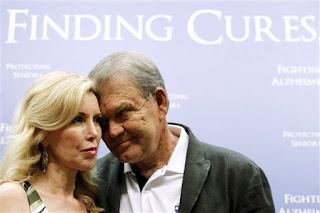By Tara KaprowyKentucky Health News
A recipe for how to improve health at the local level in Kentucky was the capstone of a day-long seminar in Frankfort Monday, with experts stressing that partnerships are key and funding will remain tight.
Communities must mobilize, prioritize, "effectivize" their actions, publicize and evaluate, measure and report performance, Trudi Matthews, director of policy and public relations at HealthBridge, summed up at the end of the Kentucky Health Quality Collaborative Conference.
The gathering was hosted by Kentucky Voices for Health in partnership with the Friedell Committee for Health System Transformation. "No single actor or set of stakeholders can solve what's wrong," Matthews said. "We really need to think across silos. We really have to collaborate."
When it comes to funding, governments "have made it very clear they will not increase the number of dollars that will be put into health care," said keynote speaker Dr. Robert Graham, national program director for Aligning Forces for Quality. "We're in a perfect storm," agreed Sue Thomas-Cox, branch manager for chronic disease prevention at the Kentucky Department for Public Health. "Federal, state and local governments don't have enough money . . . so we must work together."
Luckily, health care happens at the local level, Graham said, with hospitals and clinics unique to communities, health insurance agents locally based and consumers grounded in their communities. While there is "no particular model for how to get (change) started," Graham said, the first step is getting all stakeholders � purchasers, insurance agents, providers, consumers, faith-based organizations � around the same table. "You've got to make sure there is a balance of interests," he said.
Also key are local boards of health and health departments, whose members and staff are charged with safeguarding the health of the people of a county, under state law, and have the advantage of being "relatively untainted by the illness-for-dollars disease," pointed out Dr. Forrest Calico, a rural health consultant and longtime worker in the field.
Health departments must ensure they don't spread themselves too thin, said Dr. Steve Davis, acting commissioner for the Department for Public Health. "One of the biggest reasons why we have not moved the health needle in Kentucky is we need to be an inch wide and a mile deep," he said. Communities need to "come up with five or six things and let's hammer, hammer, hammer it," he said. Of those priorities, Davis pointed out the importance of tackling chronic disease: "That's what's killing our brethren and eating our financial lunch." For adults, he would like to see an increase in breast, cervical, colon and lung cancer screening, as well an increase in immunization rates especially for flu and pneumonia.
For children, Davis has six priorities: reduce preterm and low-birthrate babies; improve injury-prevention programs; decrease tobacco use; reduce obesity; increase immunization rates; and improve oral health.
To get more accomplished, health departments need to team up with local organizations to avoid duplication of services, which Davis said accounts for $300 billion in unnecessary spending nationwide. He added the goal is to make "1 plus 1 equal 3," with health departments needing to adopt a "do or assure" philosophy.
But there are challenges in health departments, with some local health board members failing to "roll up their sleeves," Davis said. "You can go in with nothing in your head and leave with nothing in your head," agreed Henry Bertram, chair of the Pendleton County and Three Rivers District Board of Health.
A survey of health departments showed just 46 percent of local boards of health have a vision for the next three years to improve the health status of their community and just 44 percent say they are tracking compliance for the 10 essential services they are charged with providing. And the real numbers might be worse, because the survey was voluntary.
While about half of the state's health departments are committed to working toward achieving national accreditation, only three departments � Franklin, Northern Kentucky and Three Rivers District � have actually applied for it.
Also crucial for communities is using data to identify priorities, take action and measure performance, whether using county-specific numbers at
www.kentuckyhealthfacts.org or using national data.
"We don't want to get stuck in analysis paralysis," but communities can use the data as "a story you can use as leverage," said Jan O'Neill, community engagement specialist for
County Health Rankings & Roadmaps. The County Health Rankings evaluate the morbidity and mortality rates for nearly every county in the country and rank them within a state. The rankings can act as a motivator for counties interested in effecting health changes, but "We have to be aware of their limitations" given their margins of error, especially for small counties, pointed out Al Cross, director of the
Institute for Rural Journalism and Community Issues.
O'Neill spoke of San Bernadino County in California, which used its low ranking to spur change. The county focused on its built environment, pressing hard for Walk or Wheel to School programs, community gardens and a kids community health center. O'Neill pointed out the changes are about more than infrastructure. "It's the relationships," she said. "It's the human capital ... It's many not all doing it all, but bringing what you do best. That's what mobilizing looks like."
Jodi Mitchell, executive director for Kentucky Voices for Health, said she is "starting to see a tide of change" already in Kentucky. What's important is to keep momentum building and, equally vital, ensure people are willing to participate. "If you're not at the table," she said, "you're on the menu."
Kentucky Health News is a service of the Institute for Rural Journalism and Community Issues, based in the School of Journalism and Telecommunications at the University of Kentucky, with support from the Foundation for a Healthy Kentucky.





